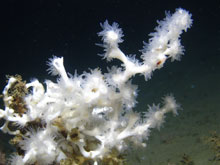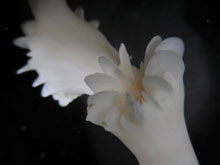Lophelia II 2009
Deepwater Coral Expedition: Reefs, Rigs, and Wrecks
August 19 – September 12, 2009

A close-up of the scleractinian coral Lophelia pertusa from the Mississippi Canyon 751 site at approximately 450 meter (137 foot) depth. This image was taken with the Seaeye Falcon DR ROV (depth-rated remotely operated vehicle) during the first cruise of this program, in September 2008. Click image for larger view and image credit.

This is the third cruise in a four-year project sponsored by the NOAA Office of Ocean Exploration and Research (OER) and the U.S. Minerals Management Service (MMS), a division of the Department of the Interior. The overall goal of this project is to explore new areas of the Gulf of Mexico in search of coral communities; in doing so, we can develop the tools to better predict the occurrence of corals and to understand why they occur where they do.
This effort begins long before we go to sea, with a group of scientists poring over industry three-dimensional seismic data and bathymetry (depth measurements) providing information on the structure and composition of the sea-floor. When a number of likely sites are chosen, we survey these "high-probability" sites with various tools to gather higher-resolution bathymetry data and to get our first real look at the seafloor. As we embark on this cruise, we have already discovered a handful of new coral sites, and we hope to discover even more.
In addition to mapping out coral distribution, we will be collecting the data necessary to fully describe the habitats of the corals, the communities associated with them, and the levels of genetic connectivity among the coral communities. We will also be collecting live corals, and transporting them back to the laboratory to conduct experiments, and to better understand the factors controlling their distribution.
During the second part of the cruise, we will also be surveying shipwrecks in order to examine the coral communities in the wrecks, as well as to describe and preserve these potentially historic sites. If we can accomplish these ambitious goals, we will be well on our way to understanding the cold-water corals of the Gulf of Mexico.
You can access the Ocean Explorer Lophelia II 2009 News Feed here:![]()
Updates & Logs
Click images or links below for detailed mission logs and updates.
 Mission Summary After nearly a month at sea, 20 dives with the remotely operated vehicle (ROV) Jason II at 17 sites (including 5 shipwrecks), and an incredible 356 hours of bottom time, the expedition claims numerous successes.
Mission Summary After nearly a month at sea, 20 dives with the remotely operated vehicle (ROV) Jason II at 17 sites (including 5 shipwrecks), and an incredible 356 hours of bottom time, the expedition claims numerous successes. September 10 A tanker that was sunk by a German U-boat during WWII, the Gulf Penn wreck has become a reef for a variety of corals, particularly Lophelia.
September 10 A tanker that was sunk by a German U-boat during WWII, the Gulf Penn wreck has become a reef for a variety of corals, particularly Lophelia. September 9 Excitement, anticipation, anxiety... The moment researchers return from the Ewing Bank dive, they begin to plan and strategize for the final and most complex recovery of this cruise.
September 9 Excitement, anticipation, anxiety... The moment researchers return from the Ewing Bank dive, they begin to plan and strategize for the final and most complex recovery of this cruise. September 8 The Ewing Banks wreck is peaceful yet poignant. The ship’s form is delineated by remnant copper sheathing and a keel centerline running the length of the vessel.
September 8 The Ewing Banks wreck is peaceful yet poignant. The ship’s form is delineated by remnant copper sheathing and a keel centerline running the length of the vessel.
 September 7 Today's mission: Explore an unidentified shipwreck actually sitting in 7,400 feet (2,255 meters) of water! The site represents the deepest historic shipwreck ever discovered in the Gulf of Mexico.
September 7 Today's mission: Explore an unidentified shipwreck actually sitting in 7,400 feet (2,255 meters) of water! The site represents the deepest historic shipwreck ever discovered in the Gulf of Mexico.  September 6 At 632 meters (2,073 feet) below the Gulf's surface and with decent visibility, scientists are able to clearly analyze the Viosca Knoll wreck.
September 6 At 632 meters (2,073 feet) below the Gulf's surface and with decent visibility, scientists are able to clearly analyze the Viosca Knoll wreck.  September 5 Participants on Leg 2 of the cruise leave the dock at Venice, Louisiana, at 6 a.m. aboard the crew transport Acadiana. Meanwhile, out in deeper waters, the research vessel Ronald H. Brown waits to exchange crews.
September 5 Participants on Leg 2 of the cruise leave the dock at Venice, Louisiana, at 6 a.m. aboard the crew transport Acadiana. Meanwhile, out in deeper waters, the research vessel Ronald H. Brown waits to exchange crews. September 4 The habitat of deep-sea corals has very little light other that what ROV Jason provides. That's one reason why images brought back from this realm are genuinely unique.
September 4 The habitat of deep-sea corals has very little light other that what ROV Jason provides. That's one reason why images brought back from this realm are genuinely unique. September 3 Check out the details of a newly discovered Lophelia reef structure in the Viosca Knoll region of the Gulf of Mexico. Note the live coral growth on top of the dead coral structure.
September 3 Check out the details of a newly discovered Lophelia reef structure in the Viosca Knoll region of the Gulf of Mexico. Note the live coral growth on top of the dead coral structure.  September 2 How do the deep-sea corals get to where they are? Where do the corals get their food? These are questions some scientists are trying to answers.
September 2 How do the deep-sea corals get to where they are? Where do the corals get their food? These are questions some scientists are trying to answers.  September 1 Cold-water stony corals, such as Lophelia pertusa, use a form of calcium carbonate called aragonite (think of a substance similar to chalk) to make their skeletons.
September 1 Cold-water stony corals, such as Lophelia pertusa, use a form of calcium carbonate called aragonite (think of a substance similar to chalk) to make their skeletons. August 30 Photomosaicking is great way to initially survey a community. This non-destructive technique lets researchers identify first-order patterns of animal distributions and biological associations.
August 30 Photomosaicking is great way to initially survey a community. This non-destructive technique lets researchers identify first-order patterns of animal distributions and biological associations. August 28 Octocorals are commonly known as the large colorful sea fans that decorate the pages of travel magazines, but they come in a wide variety of shapes and sizes, and they occur at great depths.
August 28 Octocorals are commonly known as the large colorful sea fans that decorate the pages of travel magazines, but they come in a wide variety of shapes and sizes, and they occur at great depths.  August 27 Maintaining a world-class vessel with such a diverse mission requires a highly skilled and well-trained crew consisting of a cadre of talented individuals.
August 27 Maintaining a world-class vessel with such a diverse mission requires a highly skilled and well-trained crew consisting of a cadre of talented individuals. August 26 Coral reefs are homes to fish and invertebrates that we can see with our eyes. But hidden within the complex matrix of living reefs are tiny animals that use the coral framework for habitat.
August 26 Coral reefs are homes to fish and invertebrates that we can see with our eyes. But hidden within the complex matrix of living reefs are tiny animals that use the coral framework for habitat.  August 25 There are many active, natural oil and gas seafloor seeps in the Gulf of Mexico. The same, deep, organic-rich formations of rock that oil companies drill are also “feeding” these seafloor seeps.
August 25 There are many active, natural oil and gas seafloor seeps in the Gulf of Mexico. The same, deep, organic-rich formations of rock that oil companies drill are also “feeding” these seafloor seeps.  August 24 Cold-water corals provide critical, if not essential, habitats that support a diversity of species. Some have highly intimate relationships that we are only beginning to understand.
August 24 Cold-water corals provide critical, if not essential, habitats that support a diversity of species. Some have highly intimate relationships that we are only beginning to understand.  August 23 Today scientists spent about eight hours in a frenzy of photographing, describing, documenting, identifying, preserving, and cataloging every single living or non-living specimen retrieved from the depths.
August 23 Today scientists spent about eight hours in a frenzy of photographing, describing, documenting, identifying, preserving, and cataloging every single living or non-living specimen retrieved from the depths.  August 21 See all of the major varieties of deep-sea corals, including stony corals (Scleractinia), such as Lophelia pertusa; soft corals (Octocorallia), including gorgonian sea fans and bamboo corals; black corals (Antipatharia); and hydrocorals (Stylasteridae).
August 21 See all of the major varieties of deep-sea corals, including stony corals (Scleractinia), such as Lophelia pertusa; soft corals (Octocorallia), including gorgonian sea fans and bamboo corals; black corals (Antipatharia); and hydrocorals (Stylasteridae).  August 20 The main science lab on the research vessel Ron Brown bustles with activity as the science team prepares for the first Jason dive, scheduled for just before sunset. No one has seen our first dive site before!
August 20 The main science lab on the research vessel Ron Brown bustles with activity as the science team prepares for the first Jason dive, scheduled for just before sunset. No one has seen our first dive site before!














